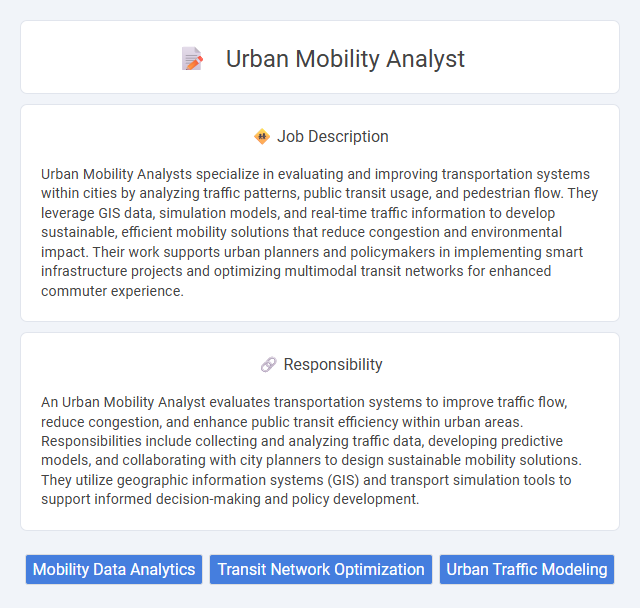
Urban Mobility Analysts specialize in evaluating and improving transportation systems within cities by analyzing traffic patterns, public transit usage, and pedestrian flow. They leverage GIS data, simulation models, and real-time traffic information to develop sustainable, efficient mobility solutions that reduce congestion and environmental impact. Their work supports urban planners and policymakers in implementing smart infrastructure projects and optimizing multimodal transit networks for enhanced commuter experience.
Individuals with strong analytical skills and a passion for sustainable transportation are likely suitable for an Urban Mobility Analyst role. Those comfortable with data interpretation and urban planning concepts may find this job aligns well with their interests and capabilities. Candidates who thrive in dynamic, problem-solving environments probably have a higher chance of success in this position.
Qualification
Proficient Urban Mobility Analysts possess strong analytical skills, expertise in GIS software, and experience with transportation modeling tools such as VISUM or TransCAD. Candidates typically hold degrees in Urban Planning, Civil Engineering, or Transportation Studies, supplemented by knowledge of data analytics and sustainable mobility trends. Effective communication skills and the ability to interpret complex data sets are essential qualifications for developing actionable urban mobility strategies.
Responsibility
An Urban Mobility Analyst evaluates transportation systems to improve traffic flow, reduce congestion, and enhance public transit efficiency within urban areas. Responsibilities include collecting and analyzing traffic data, developing predictive models, and collaborating with city planners to design sustainable mobility solutions. They utilize geographic information systems (GIS) and transport simulation tools to support informed decision-making and policy development.
Benefit
An Urban Mobility Analyst likely enhances city transportation efficiency by analyzing traffic patterns and public transit data to suggest improvements. Their work probably contributes to reduced congestion, lower emissions, and better accessibility for residents. Employers may benefit from their insights through optimized urban planning strategies and cost-effective mobility solutions.
Challenge
Urban Mobility Analysts likely face the challenge of interpreting vast and complex transportation data to identify patterns and inefficiencies in urban travel. Balancing the need for sustainable solutions with the constraints of existing infrastructure may pose ongoing difficulties. They probably encounter pressure to predict future mobility trends accurately while addressing the immediate demands of city planners and commuters.
Career Advancement
Urban Mobility Analysts leverage data analytics and transportation modeling to optimize city transit systems, making them critical in shaping sustainable urban development. Mastery of Geographic Information Systems (GIS), traffic simulation software, and policy analysis positions professionals for advancement into senior planning roles or consultancy. Continuous learning in smart city technologies and data science enhances career prospects in governmental agencies, private sector firms, and international urban planning organizations.
Key Terms
Mobility Data Analytics
Urban Mobility Analysts specialize in mobility data analytics to improve transportation systems by analyzing traffic patterns, public transit usage, and pedestrian movement. Leveraging big data, GIS tools, and machine learning algorithms, they identify inefficiencies and propose data-driven solutions for optimizing urban mobility. Their insights help city planners and policymakers design sustainable, efficient, and accessible transportation networks.
Transit Network Optimization
Urban Mobility Analysts specialize in Transit Network Optimization to enhance public transportation efficiency and accessibility. They analyze ridership patterns, travel demand, and operational data to identify bottlenecks and design improved routes or schedules that reduce travel time and increase coverage. Utilizing geographic information systems (GIS) and advanced modeling tools, these professionals support sustainable urban transit solutions that promote reduced congestion and environmental impact.
Urban Traffic Modeling
Urban Mobility Analysts specializing in Urban Traffic Modeling utilize advanced simulation software and big data analytics to predict traffic patterns and optimize transportation networks. They analyze real-time and historical traffic data, incorporating factors such as vehicle flow, pedestrian movements, and public transit usage to improve urban mobility strategies. Their work supports city planners in minimizing congestion, reducing emissions, and enhancing the overall efficiency of urban transportation systems.
 kuljobs.com
kuljobs.com